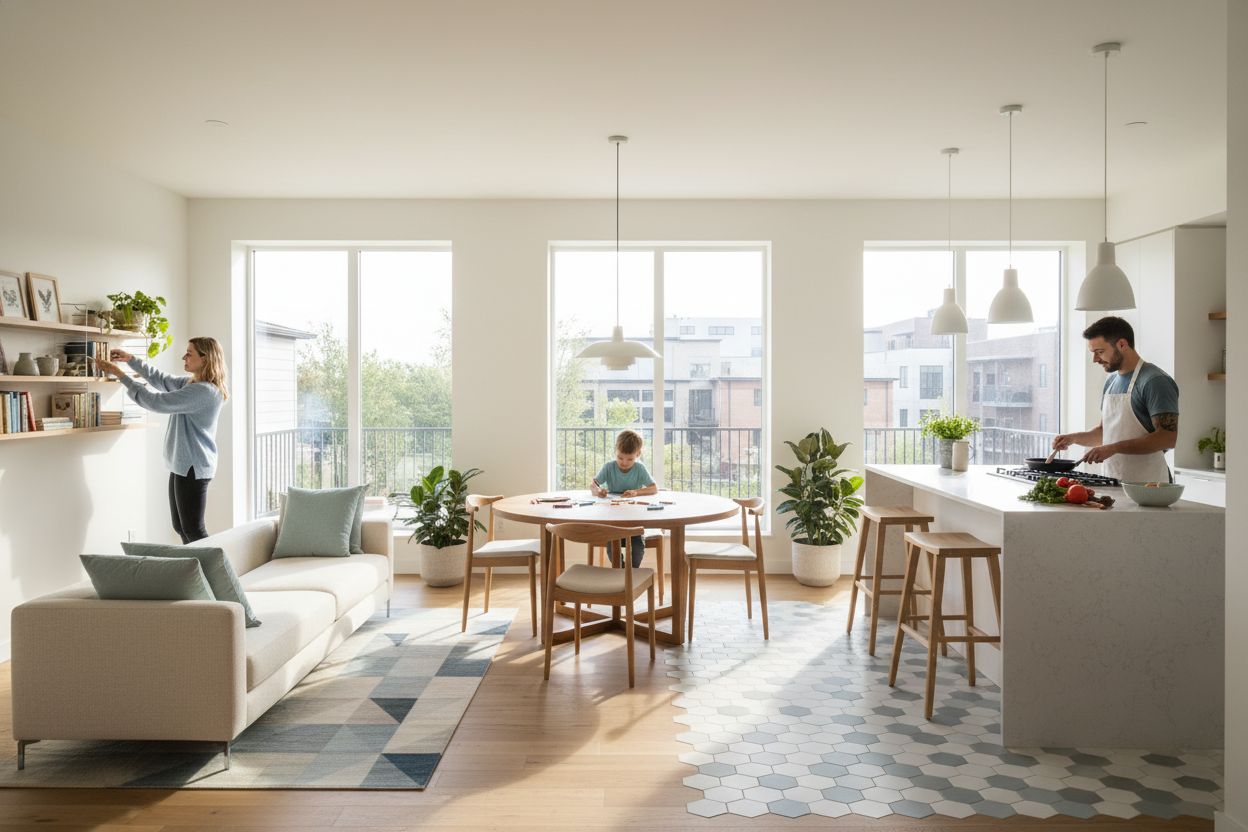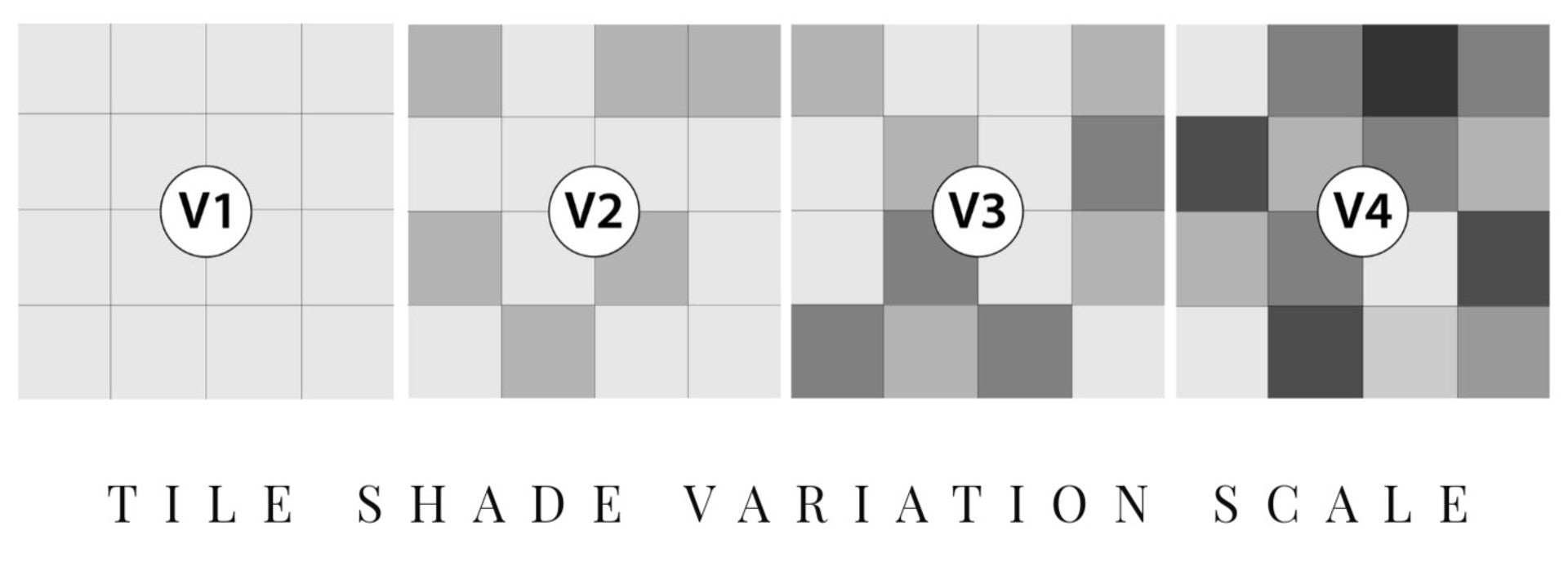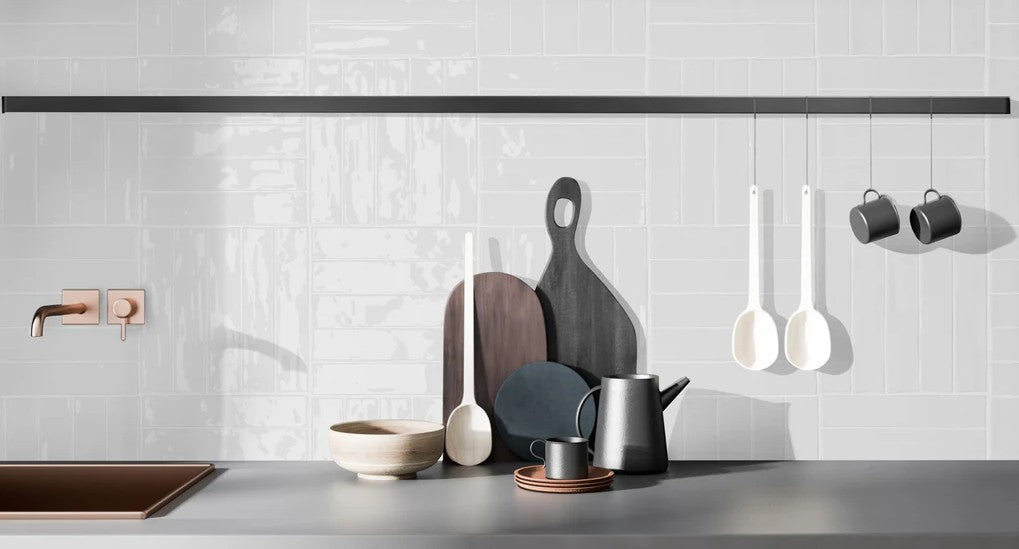Did you know that nearly 70 percent of homeowners now prefer open plan living spaces for their flexibility and modern feel? Creating a well-defined, inviting environment in these open areas can be challenging without clear boundaries. From clever flooring choices to smart storage and statement accessories, the right design decisions let you carve out distinct zones while keeping your home bright and connected.
Table of Contents
- 1. Define Zones With Tile And Flooring Choices
- 2. Maximize Light Using Glass And Open Shelving
- 3. Create Seamless Transitions With Consistent Materials
- 4. Incorporate Statement Tiles For Visual Interest
- 5. Use Furniture To Separate Living And Dining Areas
- 6. Plan Smart Storage Solutions For Clutter-Free Spaces
- 7. Add Texture And Warmth With Rugs And Accessories
Quick Summary
| Takeaway | Explanation |
|---|---|
| 1. Use Flooring to Define Zones | Select different tiles or rugs to create distinct areas in an open plan space without walls. |
| 2. Maximize Light with Open Shelving | Incorporate glass and open designs to encourage natural light flow, making rooms feel larger. |
| 3. Ensure Material Consistency | Use complementary colors and textures to establish visual harmony across different functional areas. |
| 4. Furniture as Visual Dividers | Arrange furniture strategically to subtly separate spaces while maintaining an open, airy feel. |
| 5. Layer Textures with Accessories | Add rugs and soft textiles to create warmth and inviting visual appeal in minimalist designs. |
1. Define Zones with Tile and Flooring Choices
Transforming an open plan living space into a functional and visually appealing environment starts with strategic flooring selections. Thoughtful tile and floor choices can subtly create distinct zones without using physical barriers, allowing your space to feel connected yet purposeful.
According to residential design experts, you have two primary approaches to zoning with flooring. First, you can maintain a consistent floor finish throughout to create visual continuity. Alternatively, you can deliberately introduce contrasting flooring materials to delineate different functional areas.
For practical implementation, consider these zone definition strategies:
- Use ceramic tiles in kitchen areas to create a durable, moisture resistant zone
- Select hardwood or wood look tiles in living areas for warmth and texture
- Incorporate area rugs to visually separate seating or dining spaces without permanent divisions
Architects recommend paying attention to color, texture, and material transitions. A guide on understanding tile flooring choices can help you select complementary materials that enhance your open plan design.
The key is creating a seamless yet intentional flow. Your flooring choices should feel like a natural progression, guiding movement through the space while subtly indicating each area’s unique purpose. With careful selection, your floors can become a design element that defines and elevates your open plan living environment.
2. Maximize Light Using Glass and Open Shelving
Light transforms open plan living spaces from ordinary rooms into vibrant environments where functionality meets aesthetic appeal. Glass elements and open shelving create visual transparency and allow natural light to flow seamlessly throughout your interior, making even compact spaces feel expansive and interconnected.
Open shelving serves multiple design purposes beyond simple storage. These airy structures permit light to pass through unobstructed while providing strategic opportunities to display decorative items or functional kitchenware. Glass panels or transparent room dividers work similarly background can be seen through them, maintaining an uninterrupted visual landscape.
To implement this approach effectively, consider these strategic techniques:
- Install glass tile backsplashes to reflect and amplify natural light
- Select open metal or wooden shelving with minimal visual blockage
- Position shelves near windows to maximize light transmission
- Choose light colored or translucent materials for maximum brightness
When selecting glass or open shelving solutions, prioritize materials that complement your existing design aesthetic. Understanding the difference between wall and floor tiles can help you select complementary transparent design elements that enhance your overall space.
The magic of glass and open shelving lies in their ability to create depth without heaviness. They invite light to dance through your living areas while maintaining an sense of openness and connection. By thoughtfully integrating these elements, you transform your interior into a luminous environment that feels simultaneously structured and free flowing.
3. Create Seamless Transitions with Consistent Materials
Open plan living spaces thrive on visual harmony and smooth spatial connections. Consistent material choices act as the secret ingredient that transforms disconnected areas into a unified living environment, creating a sense of flow and sophistication throughout your home.
Residential design professionals emphasize that maintaining material continuity does not mean everything must look identical. Instead, it means selecting complementary colors, textures, and finishes that communicate a cohesive design language across different functional zones.
When approaching material consistency, consider these strategic approaches:
- Select tile or flooring with similar color palettes across different areas
- Choose materials with comparable visual weights and textures
- Repeat material elements like trim or baseboards throughout the space
- Use transitional pieces that bridge different flooring types smoothly
According to design experts, even subtle variations can create visual interest while preserving overall harmony. Understanding the difference between wall and floor tiles can help you select materials that work together seamlessly.
The goal is creating a space that feels intentional and thoughtfully designed. By carefully selecting consistent materials, you invite a sense of calm and sophistication into your open plan living area. Your space becomes a canvas where each zone connects effortlessly while maintaining its unique functional identity.
4. Incorporate Statement Tiles for Visual Interest
Statement tiles are the artistic punctuation marks of open plan living design transforming ordinary spaces into extraordinary experiences. Bold tile choices can instantly elevate your interior by creating focal points that draw the eye and define functional zones without requiring physical barriers.
Designers recognize that strategic tile selections do more than cover floors. They communicate style, break visual monotony, and provide opportunities for creative expression within your living environment. A carefully chosen tile can act like a visual anchor that subtly guides movement and defines different areas of your open plan space.
To effectively incorporate statement tiles, consider these strategic approaches:
- Select tiles with unique geometric patterns
- Choose contrasting colors that complement your overall color scheme
- Create tile “rugs” in transition areas like entryways or dining spaces
- Mix textures and finishes for added visual complexity
When exploring statement tile options, look for pieces that reflect your personal aesthetic. A Myorka 4 x 4 Blue Ceramic Tile could introduce a pop of color, while a graphite hexagon tile might add sophisticated geometric intrigue to your space.
Remember that statement tiles are not just decorative elements. They are strategic design tools that can visually expand your space, create rhythm, and tell a story about your home’s personality. By thoughtfully integrating these design statements, you transform functional surfaces into true design opportunities.
5. Use Furniture to Separate Living and Dining Areas
Furniture is more than just functional decor it can be a powerful design tool for creating invisible boundaries in open plan spaces. Strategic furniture placement allows you to define distinct zones without installing walls or permanent dividers, maintaining the spacious feel of your living environment while providing clear functional separation.
In open concept homes, furniture acts like a visual choreographer. A well positioned sofa can signal the living area boundary. A dining table strategically placed can demarcate the eating zone. These furniture arrangements create psychological and physical transitions between different functional spaces without disrupting the overall sense of openness.
To effectively use furniture for zone separation, consider these practical techniques:
- Position a console table or bookshelf as a room divider
- Use area rugs to anchor and define specific furniture groupings
- Select furniture with different heights to create visual hierarchy
- Arrange seating to create natural traffic flow between zones
Understanding the difference between wall and floor tiles can further help you complement your furniture zoning strategy with complementary tile choices that enhance these spatial definitions.
The art of furniture zoning is about creating subtle boundaries that feel natural and intuitive. By thoughtfully positioning your pieces, you transform your open plan space into a dynamic environment where each area feels distinct yet interconnected. Your furniture becomes more than mere objects it becomes the architecture of your living experience.
6. Plan Smart Storage Solutions for Clutter-Free Spaces
Open plan living demands a strategic approach to storage where functionality meets aesthetic elegance. Intelligent storage solutions transform potential chaos into streamlined spaces that look effortlessly organized, ensuring your living area remains both beautiful and practical.
In open concept layouts, clutter becomes immediately visible. Professional remodeling experts emphasize that storage is not just about hiding items but creating integrated systems that maintain visual harmony. Multifunctional furniture and built in solutions become critical tools for maintaining a clean and sophisticated environment.
To create effective storage strategies, consider these practical approaches:
- Install floor to ceiling built in cabinets with clean lines
- Select furniture with hidden storage compartments
- Use floating shelves to display select items while maintaining openness
- Incorporate deep drawers in kitchen islands and living room furniture
Understanding the difference between wall and floor tiles can help you select complementary surfaces that enhance your storage design and maintain a cohesive visual flow.
The ultimate goal of smart storage is creating spaces that breathe. Your storage solutions should feel like natural extensions of your design rather than afterthoughts. By thoughtfully integrating storage into your open plan layout, you create an environment that feels simultaneously organized and expansive a true reflection of modern living design.
7. Add Texture and Warmth with Rugs and Accessories
Accessories and textural elements are the secret ingredients that transform open plan spaces from sterile to soulful. Rugs and carefully selected accessories breathe life into minimalist environments, creating layers of visual and tactile interest that make your living space feel genuinely inviting and personal.
In open concept designs, rugs serve multiple critical functions beyond mere decoration. They anchor furniture groupings, define functional zones, absorb sound, and introduce warmth to potentially stark industrial spaces. Textiles become visual punctuation marks that soften architectural lines and create psychological comfort within expansive areas.
To effectively incorporate texture and warmth, consider these strategic techniques:
- Layer multiple rugs with different textures and complementary colors
- Select plush upholstered furniture to introduce soft surfaces
- Mix natural materials like wool, cotton, and woven textiles
- Use throw pillows and blankets to add visual and tactile depth
Understanding luxury vinyl tile versus ceramic flooring can help you select foundational surfaces that complement your textural accessories.
The art of accessorizing is about creating subtle emotional responses. Your chosen elements should feel intentional yet effortless. By thoughtfully integrating rugs and accessories, you transform an open plan space from a mere architectural concept into a living breathing environment that tells your unique design story.
This table summarizes the main strategies and considerations for optimizing open plan living spaces through flooring, lighting, materials, design elements, furniture arrangement, and storage solutions.
| Strategy | Implementation | Expected Results |
|---|---|---|
| Define Zones | Use different flooring types, like ceramic in the kitchen and hardwood in the living areas. | Creates distinct areas while maintaining an open feel. |
| Maximize Light | Integrate glass elements and open shelving to allow natural light to flow throughout the space. | Expands and brightens living spaces. |
| Create Seamless Transitions | Use consistent materials with complementary colors and textures across zones. | Achieves visual harmony and flow. |
| Incorporate Statement Tiles | Employ bold, geometric tile patterns as focal points. | Adds visual interest and defines areas without barriers. |
| Use Furniture for Separation | Arrange furniture like sofas as invisible room dividers. | Maintains openness while delineating functional spaces. |
| Plan Smart Storage Solutions | Opt for built-in cabinets and multifunctional furniture with hidden storage. | Keeps spaces organized and clutter-free. |
| Add Texture and Warmth | Use rugs and accessories to introduce texture and depth. | Enhances warmth and personalization of minimalist designs. |
Elevate Your Open Plan Living with Expert Tile Solutions
Creating distinct and stylish zones in an open plan living space can be challenging without clutter or closed doors. This article highlights the importance of thoughtful tile and flooring choices to define areas naturally while maintaining a sense of flow and connection. Whether you want to incorporate statement tiles as artistic focal points or achieve seamless transitions with consistent materials, the right tile selection can transform your living area emotionally and functionally.
At TileChoices.com, we understand your goal to balance elegance and practicality. Explore our wide range of tiles including ceramic, porcelain, glass, and natural stone options designed to help you create zones that feel intentional and inviting. From durable kitchen backsplash tiles to sophisticated floor and wall tile options, our curated collections provide the quality and style your open living plan deserves.
Ready to redefine your living space with expert tile solutions that match your unique vision? Discover how easy it is to bring your open plan ideas to life by visiting TileChoices.com today and browse our inspiring selections. Take the first step now toward a beautiful home where every zone makes a statement without walls.
Frequently Asked Questions
How can I define zones in an open plan living space?
To define zones in an open plan living space, use different flooring materials or color schemes for each area. For example, use ceramic tiles in the kitchen and hardwood in the living room to create a visual distinction.
What furniture can I use to separate living and dining areas?
You can use couches, console tables, or bookshelves to create subtle dividers between living and dining spaces. Position a console table behind a sofa to mark the transition while maintaining an open feel.
What are effective storage solutions for open plan living?
Effective storage solutions include built-in cabinetry or furniture with hidden storage options. Plan for floor-to-ceiling cabinets with clean lines to maximize space and keep your area organized.
How can I maximize natural light in an open plan space?
Maximize natural light by incorporating glass elements or open shelving. For instance, install glass tile backsplashes in the kitchen to reflect light and create a brighter atmosphere.
What types of rugs should I use in an open plan living area?
Choose rugs with different textures and complementary colors to define areas and add warmth. Layer rugs to create depth; for instance, using a plush area rug on top of a larger jute rug can enrich your space’s aesthetic.
How can I add visual interest with statement tiles?
Incorporate statement tiles by selecting those with unique patterns or bold colors to create focal points. For example, use geometric tiles in a hallway or entryway to make a strong design statement.
Recommended
- Master Mixing Tile Patterns for Stunning Spaces – Tile Choices
- 8 Luxury Bathroom Tile Ideas for a Stunning Makeover – Tile Choices
- Mastering Designing Small Bathrooms: Space-Saving Solutions – Tile Choices
- 10 DIY Home Improvement Tips for Better Living Spaces – Tile Choices
- How to Make Your Home More Welcoming | Simple Neat Home









